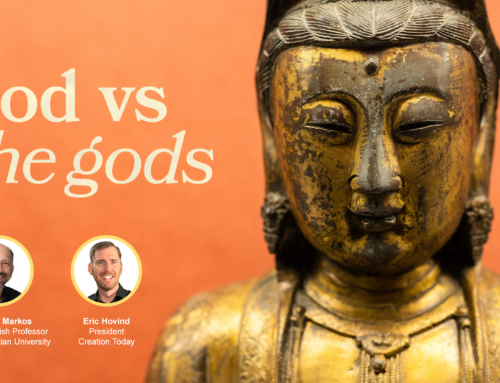For those who can’t stand the suspense of wondering what my position is on this vital question, you can have my answer right now. It’s a definitive “Don’t know!”
But one recent article suggests that some people think that they do know.1 It makes no difference to anyone’s position on the truth or otherwise of evolution whether or not these dinosaurs were nocturnal, but the substance of the paper provides an extremely good example of the way that popularizers of evolution use language.
The substance of the article is this: Researchers claim that larger eyes are more likely to be found in nocturnal rather than diurnal animals. The researchers then looked at the eye sockets of small dinosaurs, which they assume were carnivorous predators, such as a type of velociraptor, and decided that the animals must have had large eyes, and therefore must have been nocturnal. The article makes this remarkable claim:
In the long-ago age of the dinosaurs, the smaller, fierce and predatory beasts were night hunters, stalking and seizing their unwary prey in the dark, while giant plant eaters of the same era browsed both day and night in order to fill the energy needs of their huge bodies.2
Do the writers of such articles ever stop to marvel about how the sort of information given above could possibly be gleaned from a pile of dead fossilized bones? No wonder one evolutionary paleontologist admitted:
What paleontologists know about the past is as much a product of their imaginations as it is dusty fossils extracted from rocks.3
In the above quote, Dr Eric D. Gyllenhaal is not writing negatively. His comment, in context, shows that he approves of such use of imagination, believing it to be a necessary tool. We must remember this, when we read such accounts of supposed dinosaur behavior. Evolutionists not only create such scenarios by imagination, they believe that they are justified in doing so, and that such leaps of imagination are part of a valid scientific narrative. Now it would not worry me if these dinosaurs did indeed turn out to be nocturnal predators—many dinosaurs must have become predators after Adam sinned and, since there are nocturnal animals today, it makes sense to suppose that some would have been nocturnal in the early years after the Fall of Adam as well. The point I am making is that it is a non-issue. And with present knowledge, there is no way of finding out whether or not such animals were nocturnal or diurnal. Yet, the researchers have found enough material using their imagination to publish a paper in the journal Evolution, and the San Francisco Chronicle have found enough material to fill a news column. It will be useful to see how they do it. (The emphases in the news article quotes following are not original—they are mine.)
The news article reports:
This new picture of dinosaur behavior, based on studies of the fossil bony structures of their eyes, has been drawn by paleontologists at UC Davis, and it challenges some long-held ideas about the way dinosaurs lived.
The emphasized phrases are common in such articles. The supposed “new picture” is really a “new story,” or even a “new fiction,” because it is a product of imagination. But the “long-held ideas” were also a product of imagination. No one really knows very much about the behavior of these animals, so the concept of “challenging long-held ideas” is somewhat hollow. The use of such phrases gives an impression of scientific research and hence lends an undeserved authority to the ideas.
They measured the fossil eye bones of 33 varied dinosaurs, including those that lived on land like velociraptor of movie fame and archaeopteryx, the first flying bird, as well as diplodocus, the long-necked land giant that gorged on leaves and ferns and all sorts of other vegetation.
I guess it is fair enough to remind readers that velociraptor was a star of the film “Jurassic Park.” But this brings to mind the many leaps of imagination that the novel and film used in describing the supposed behavior of this dinosaur, ascribing it a form of problem-solving intelligence, which cannot possibly be gleaned from the fossils. While actual evolutionary scientists would not necessarily make the claims that the character Alan Grant makes, the allusion to the film brings all his ideas to mind for the ordinary reader of this article. I was immediately reminded of the scene where Dr. Grant explains the intelligent predatory behavior of velociraptor to an initially skeptical, then horrified, small boy at a fossil dig.
It is notable that the article misses the opportunity to mention another occasion when “long-held ideas” were challenged. The article refers to archaeopteryx as “the first flying bird.” Archaeopteryx was indeed a true bird, but it is not so long since evolutionists were claiming that it was the missing link between dinosaurs and birds. While not making that error, the allusion was nevertheless made in the next article, as Perlam reports:
They also examined the eye bones of 164 modern birds, because the birds—as dinosaur experts now maintain—are, in fact, living dinosaurs.
So, the article has not actually claimed that archaeopteryx is a missing link, but the inference has been made in people’s minds. It might also be instructive to consider the phrase “dinosaur experts.” Obviously, the ordinary ignorant reader should never question that birds evolved from dinosaurs, because experts have pronounced on the matter! To back up an assertion only by stating that it is the opinion of experts is a logical fallacy known as the argument from authority. And the article compounds these errors later by describing archaeopteryx as “a flying dinosaur.” We need to repeat this, to make sure the point is understood. Archaeopteryx was not, and is not, a missing link. It is not part dinosaur, part bird. It was a genuine bird.
It is possible that some Christians may be intimidated by articles such as this. After all, they are reports of scientific research. Hopefully, you now begin to see that it does not take a degree in science to pick apart science articles in newspapers. The actual evidence that they claim for evolutionary behavior does not exist in the bones of the fossils—it exists only in the imagination of the paleontologists and in their use of the language of evolution.4
- Perlam, D. (2011), UC Davis Dinosaur Eye Bone Study Offers New View, < http://www.sfgate.com/cgi-bin/article.cgi?f=/c/a/2011/04/17/MNIA1J1N7E.DTL >. Perlam says that the original article has been published in both Science Express and Evolution. At the time of writing, I have not been able to find these references, so, presumably, the publication date must be June 2011 onwards. ↩
- This quote, and any further quotes which appear uncredited, are from reference 1. ↩
- Eric D. Gyllenhaal, < http://saltthesandbox.org/dinosaurs/parents.htm > ↩
- The velociraptor skull image is from Wikimedia Commons, < http://commons.wikimedia.org/wiki/File:Dinosaur_99.jpg >, licensed under Creative Commons Attribute-Share Alike 3.0 Unported license. ↩






